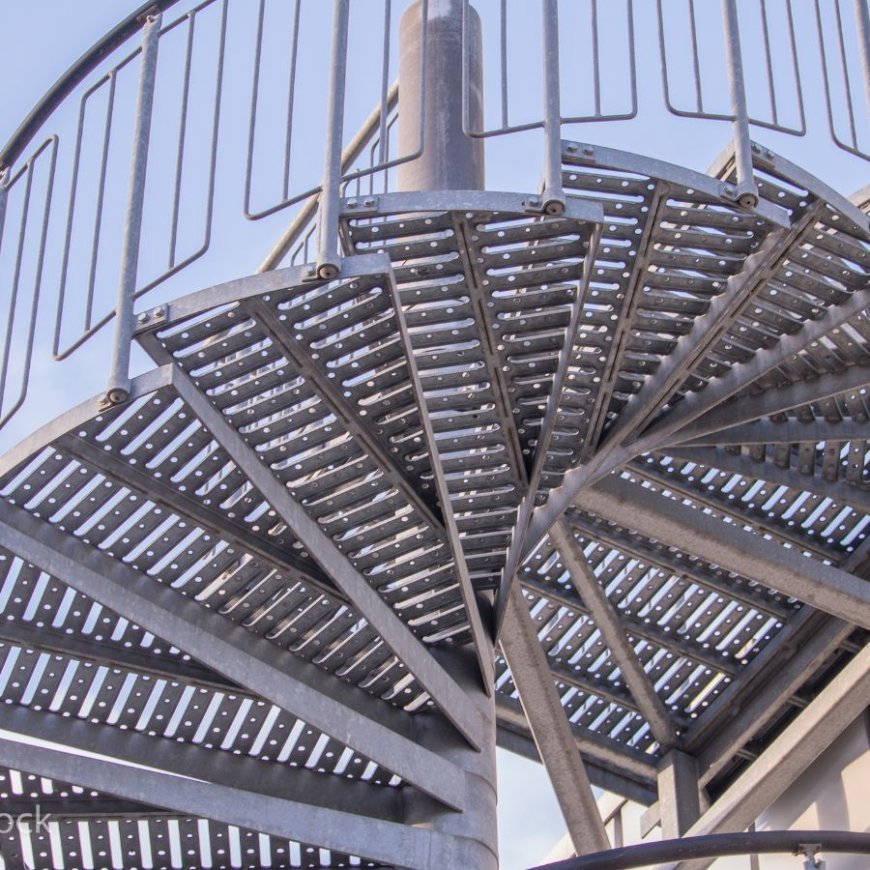What Design Options Do Steel Staircase Manufacturers Offer?

In modern architecture, staircases are no longer just functional elements—they’re a design statement. Whether you're remodeling your home or designing a commercial building, the right staircase can enhance visual appeal, improve traffic flow, and boost property value. Among the most versatile and durable materials, steel stands out as a top choice for builders, architects, and homeowners alike.
But what exactly do steel staircase manufacturers offer in terms of design? From classic straight staircases to sleek floating designs, the possibilities are endless. In this article, we’ll explore the full spectrum of design options offered by steel staircase manufacturers to help you make an informed decision for your next project.
The Strength of Steel: Why Choose Steel Staircases?
Durability and Longevity
Steel staircases are prized for their structural integrity. Unlike timber, which can warp or rot over time, steel remains strong and stable for decades. It resists corrosion—especially when galvanized or powder-coated—and is suitable for both indoor and outdoor applications.
Modern and Industrial Appeal
Steel complements a variety of design themes, from sleek, minimalistic modern homes to industrial lofts and commercial buildings. Its clean lines, sharp angles, and potential for unique finishes make it a favorite among architects and interior designers.
Custom Fabrication Possibilities
One of steel’s biggest advantages is its adaptability. Manufacturers can custom-build staircases to exact specifications, ensuring a perfect fit and tailored appearance, regardless of space limitations or aesthetic preferences.
Key Design Styles Offered by Steel Staircase Manufacturers
Straight Staircases
Straight stairs are a timeless option. They offer a clear, unobstructed path between two levels and are often easier and quicker to fabricate. They work well in both residential and commercial settings and can be enhanced with railings, landings, and various finishes.
L-Shaped & U-Shaped Staircases
These styles feature one or two landings that create a 90° or 180° turn, respectively. They are excellent space-saving solutions and provide natural pause points while ascending or descending. Their angular design adds architectural interest and improves safety.
Spiral Staircases
Spiral staircases are a beautiful solution for tight spaces. They form a compact footprint, making them perfect for lofts, decks, and small apartments. Steel’s flexibility and strength allow manufacturers to create highly durable and visually stunning spiral designs.
Curved Staircases
Curved stairs elevate a space with elegance and grandeur. They require precision engineering and are often seen in luxury homes and commercial entrances. The sweeping curve creates a sense of fluidity and movement that is hard to achieve with other designs.
Floating or Cantilevered Stairs
Floating stairs, also known as cantilevered stairs, give the illusion of treads suspended in mid-air. They’re anchored to a wall or hidden support beam and are popular in modern, high-end homes. While these designs are structurally complex, steel’s strength makes them possible.
Customization Options for Treads, Risers, and Stringers
Tread Materials
Steel staircases can incorporate various materials for the treads:
-
Solid Steel Plates – Durable and ideal for industrial applications.
-
Timber Overlays – Adds warmth and contrast for residential settings.
-
Glass Treads – For a luxurious, transparent look.
-
Concrete or Stone Inserts – Heavy-duty, modern appearance.
-
Perforated/Checker Plates – Non-slip and commonly used in factories or fire escapes.
Riser Variants
-
Open Risers – These create a light, open look and allow for better visibility and airflow.
-
Closed Risers – Add a traditional touch and may enhance soundproofing and privacy.
Stringer Types
-
Mono Stringers – Single central beam for a minimalist appearance.
-
Double Stringers – Positioned on each side for extra support.
-
Side-Mounted Stringers – Often used in commercial staircases or as part of architectural features.
Handrail & Balustrade Options: Safety Meets Aesthetics
Material Choices
-
Mild Steel – Cost-effective and versatile.
-
Stainless Steel – Sleek, corrosion-resistant, and ideal for modern interiors.
-
Powder-Coated Steel – Available in custom colors for personalized aesthetics.
-
Timber or Glass – Mixed-material railings for a softer or more open look.
Balustrade Designs
-
Vertical Bars – Classic and compliant with most building codes.
-
Wire Cable Balustrades – Modern, subtle, and great for maximizing views.
-
Laser-Cut Panels – Customizable patterns that double as artistic statements.
-
Glass Panels – Offer unobstructed sightlines and high-end appeal.
Surface Finishes & Protective Coatings
Powder Coating
Powder coating is a durable, eco-friendly finish that comes in a wide range of colors and textures. It protects the steel from corrosion and scratches while offering a smooth, attractive look.
Galvanizing
Galvanizing involves coating steel with zinc to prevent rust—ideal for outdoor staircases or humid environments. It’s often used in commercial and industrial applications where longevity is critical.
Brushed, Polished, or Painted Finishes
For interior use, brushed or polished finishes create a sophisticated appearance. Painted steel can also match any décor and offer another layer of protection.
Integration with Other Materials
Steel staircases don’t exist in a vacuum—they often incorporate complementary materials to enhance their function and appeal.
Steel and Timber
Combining the strength of steel with the warmth of wood creates a balanced and inviting design. Timber treads on steel stringers are popular in homes and boutique offices.
Steel and Glass
Glass adds transparency and elegance. Used for balustrades or treads, it brings a light, airy feel to even the heaviest staircases.
Steel and Concrete
This pairing suits industrial or minimalist designs. Concrete treads on steel frames create a rugged, durable structure perfect for modern commercial buildings.
Residential vs Commercial Staircase Designs
Residential Applications
In homes, aesthetics often take center stage. Steel staircases are customized to match interior décor and may include child-safety features, integrated lighting, and unique finishes.
Commercial/Industrial Applications
In workplaces, safety, compliance, and traffic flow are key. Steel staircases must meet strict building codes, handle high foot traffic, and incorporate anti-slip materials, fire resistance, and heavy-duty construction.
Building Code Compliance and Safety Standards
Steel staircase manufacturers must adhere to regional and national codes. In Australia, for instance, staircases must meet BCA (Building Code of Australia) standards, which dictate:
-
Minimum tread depth and maximum riser height.
-
Handrail height and continuity.
-
Balustrade spacing to prevent falls.
-
Load-bearing capacity and slip resistance.
Failure to comply can result in fines, project delays, or safety hazards.
Custom Design Process: From Concept to Installation
Site Measurement and Consultation
Every steel staircase starts with an on-site assessment. This ensures accurate dimensions, weight support, and design feasibility. Manufacturers consult with clients to understand their style, budget, and functional needs.
3D Modeling and CAD Drafting
Using advanced software, manufacturers produce detailed renderings and CAD files. This step allows for visual previews, modifications, and structural validation before fabrication begins.
Fabrication and Installation
Once designs are approved, fabrication begins—cutting, welding, and assembling components. On-site installation is usually the final step, often completed by the manufacturer or a trusted contractor.
Cost Factors and Budget Considerations
Design Complexity
The more intricate the design—like curved or floating stairs—the higher the cost due to added labor, materials, and engineering.
Material Selection
Glass, timber, and powder-coated finishes can increase prices but offer elevated aesthetics and durability.
Labor and Installation
Labor costs depend on site access, staircase location, and any modifications needed to fit the structure.
Sustainable Design Options
Many manufacturers offer environmentally conscious options:
-
Recycled Steel – Reduces carbon footprint without compromising strength.
-
Low-VOC Finishes – Better for indoor air quality.
-
Durability Equals Sustainability – Long-lasting steel stairs reduce the need for replacement, conserving materials and energy.
Conclusion: Endless Possibilities with Steel Staircase Designs
Steel staircase manufacturers offer a world of design possibilities—from sleek, minimal floating stairs to grand curved showpieces. With customizable materials, finishes, and structural components, steel stairs can be tailored to suit any residential or commercial setting.
Whether you're designing a cozy home loft or a modern office entryway, working with a professional steel staircase manufacturer ensures safety, style, and long-term value. Invest in a staircase that doesn’t just get you from point A to B—but makes the journey unforgettable.
Frequently Asked Questions (FAQs)
1. What is the most space-saving staircase design offered by steel staircase manufacturers?
Spiral staircases are the most efficient in terms of space, taking up minimal floor area while maintaining accessibility.
2. Can I customize the color of my steel staircase?
Absolutely. Powder coating allows for virtually unlimited color options and even textured or matte finishes.
3. Are steel staircases noisy when used?
With proper engineering and materials like rubber tread inserts or timber overlays, noise can be significantly minimized.
4. Is it possible to install steel staircases outdoors?
Yes. With galvanizing or weather-resistant powder coatings, steel staircases perform excellently in outdoor environments.
5. How long does it take to manufacture a custom steel staircase?
It typically takes between 4 to 8 weeks, depending on complexity, materials, and workload at the manufacturer’s facility.
6. What is the maintenance required for a steel staircase?
Minimal maintenance is needed—occasional cleaning and inspections are sufficient. Outdoor stairs may require periodic recoating.
7. Can steel stairs be integrated into heritage or timber homes?
Yes. Many designs combine steel with timber for a seamless blend that suits both traditional and modern aesthetics.
What's Your Reaction?






























































